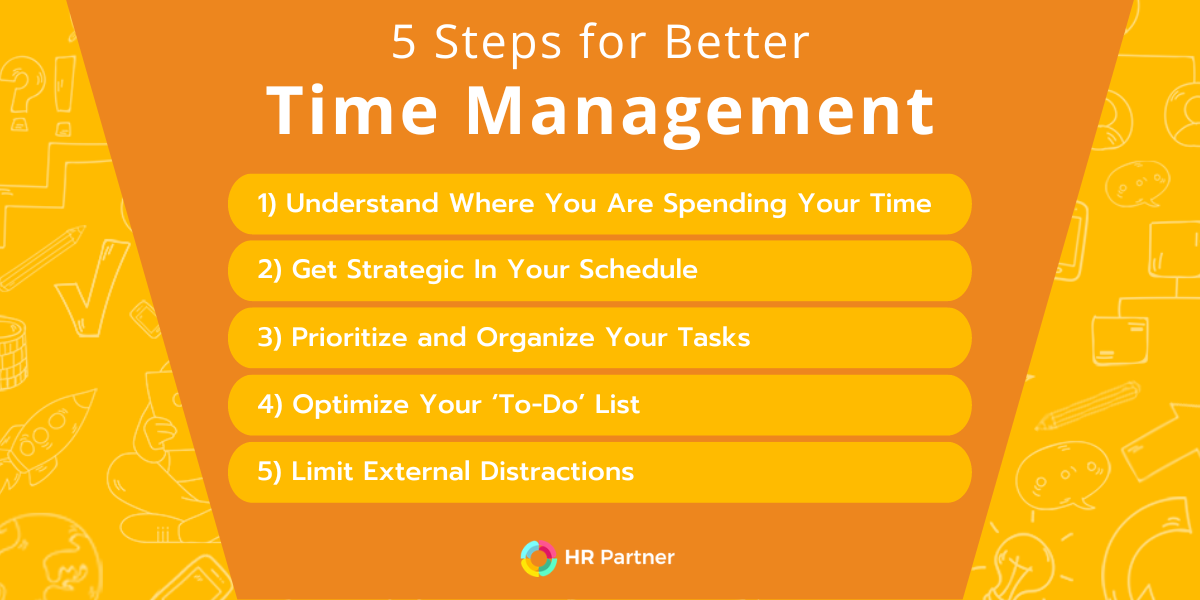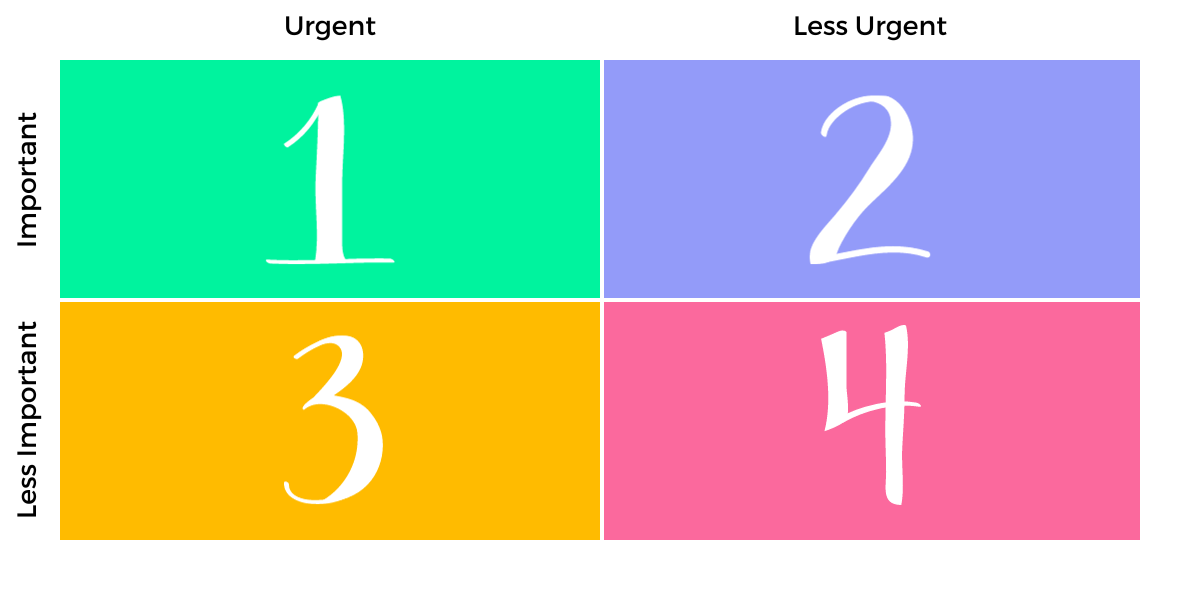If anyone needs to master time management, it’s HR professionals! But time management isn’t just about keeping track of your hours. It’s a holistic approach that involves organizing, planning, and scheduling tasks to maximize productivity and effectiveness. When done correctly, mastering the clock can help achieve more quality work in less time. Whereas inefficient use of time can lead to stress, missed targets, and poor performance.
If you’re a small team, or even a department of one running the entire Human Resources (HR) department at your company, efficiency and productivity are crucial. Whether you’re constantly finding yourself juggling various tasks within limited hours, or you want to better optimize your workday, here’s how to improve your time management:

1. Understand Where you Spend Your Time
Think of auditing your time like a budgeting exercise – it isn’t fun, but it’s necessary to determine where your time is being spent. For the next week or two, maintain a diary detailing every activity within your workday. Once you have a better idea of how your day is being spent, you can adjust how you manage your time in the future and develop a plan for maximum productivity.
Tip: Consider using a time-tracking app or a simple digital spreadsheet. This will help you organize your notes, categorize your activities, and visualize patterns.
2. Get Strategic with your Daily, Weekly, and Monthly Schedule
A well-organized calendar is a powerful tool. By pre-scheduling tasks and appointments, you can better plan for your days, weeks, and months. This will help keep you on track and set yourself up for success by ensuring you’re getting important tasks and goals accomplished in a timely manner.
Utilize Time Blocks
Allocate specific time blocks for tasks, and ensure you stick to them. The key is to consider realistic timelines and give your full attention to the task at hand.
According to theories like the planning fallacy, a task will always take longer than estimated to complete. Keep this in mind when you’re planning out your daily tasks, and allocate more time as a buffer.
Tip: Eliminate distractions by closing unrelated browser tabs, putting team chats on “do not disturb” or “busy”, and keeping your phone out of immediate reach.
Start a Monthly Focus Day
As an HR professional, it’s your job to not only make sure you have the tools and ability to be productive but to ensure your workforce does as well. Cal Newport’s concept of Deep Work suggests that dedicating blocks of uninterrupted time to complex tasks can significantly enhance productivity and innovation. Implementing a company-wide “focus day” can help ensure employees are carving out specific periods in their schedule, undisturbed, to focus on tasks that require deep thinking and concentration.
Tip: Suggest allocating one day each month to focus on a significant project or initiative without any distractions like meetings, email, or team chats. Some companies even do a “meeting-free” day each week for this purpose!
3. Prioritize and Organize Your HR Tasks
To-do lists can be an effective tool, but only when done right. Take out a piece of paper and write down all of your ‘to dos’ for the week.
Now, let’s use the Eisenhower Matrix to help prioritize your tasks based on urgency and importance. It categorizes tasks into four quadrants:

- Tasks to do immediately: Important and urgent tasks which have upcoming or missed deadlines. These need to be done now, but it’s important to think about what can be done to reduce the urgency in the future.
- Tasks to schedule for later: Tasks that are important but not urgent are often the most significant ones that will help move the needle!
- Tasks to delegate: Tasks that need to be done soon, but are less important and can be handled by others should be delegated wherever possible.
- Tasks to delete: Not important or urgent tasks that don’t align with your objectives.
This exercise will help simplify your to-do list and ensure you’re focusing on the right tasks. Ideally, you’ll move towards spending most of your time in quadrant 2 – important but less urgent / reactive work – as this is almost always how you’ll make your biggest impact.
If you’re finding yourself stuck in quadrant one and three – doing urgent tasks that may or may not be important, it’s time to think about how you could circumvent those tasks. In the world of HR, often having the right systems in place can make all the difference. For instance, if employees are querying their PTO / leave balances, doing onboarding manually, checking other details, or can’t find important company documents, a system like HR Partner can make a huge difference. This can also make recruiting far more efficient too – which is often one of the more time consuming elements of a HR role.
4. Optimize Your HR ‘To-Do’ List
Now that you determined what tasks are a priority, it’s time to start checking them off your list. Here are actionable tips and tactics to implement:
Tackle Big Tasks First
Focus on your most challenging and essential task first, then you can continue down your list.
Have you heard of the Pickle Jar Theory? It suggests that time, like the space in a pickle jar, is limited. If not managed properly, you may be using your limited time accomplishing many small unimportant tasks that take away time from the big important tasks. It’s essential to do the big things first, as the smaller things can fit around them – but it doesn’t work the other way around.
Tip: Identify your most significant task for the day and tackle it before anything else. If it’s a big task, just commit to spending 2 hours, or even just 45 minutes on this task to move it forward and make some progress. If possible, try to assign your to-do list from most important to least important, and only move to the next task once the prior task is completed.
Group Similar Tasks Together
By batching or grouping similar tasks, you can work more efficiently and maximize productivity. For instance, if possible, allocate specific days of the week exclusively for meetings, so you can spend the other days focusing on your projects or tasks. For instance, you might have a half day you designate to working on policies, or another half day where you work on workforce planning.
You can also set aside dedicated time slots for responding to emails like first thing in the morning and right after lunch.
5. Limit External Distractions
Last, but not least, limit external distractions when possible. You’ve probably heard about the research that shows the enormous amounts of time we lose due to switching tasks – and it’s all true! Actions we can take to keep focused and reduce distractions cannot be underestimated! Here are some tips…
Minimize Meetings
While meetings are essential for communication and decision-making, some discussions can be done over email or alternative communication methods. By reducing the frequency and duration of meetings, you can reclaim valuable hours to focus on other pressing tasks.
Tip: For the meetings you do need, make it a requirement to have a pre-written agenda so that you have clarity for the meeting, and you can evaluate whether it really needs to be a meeting.
Use Designated Office Hours
Implementing specific office hours for addressing routine and HR administrative questions can help set boundaries and maximize your time. It ensures that repetitive, yet necessary, questions or tasks are being completed and answered efficiently, without interrupting your focus time.
Tip: Establish specific hours that you’re available to answer questions or help with tasks from other departments. You could also have office-hours for employee questions and discussions too. This can be bi-weekly, weekly, or monthly depending on your bandwidth.
Learn When to Say No
We have only so much energy in a day. To avoid half-baked work, know your limits and be willing to say no. Recognize your strengths and weaknesses, and focus on what you’re good at. If possible, delegate what can be done better and faster by other people.
…
The combination of strategic scheduling, prioritization, and designating time to focus can be transformative. Implementing these time management practices promises a pathway to enhanced productivity, effectiveness, and well-being.

